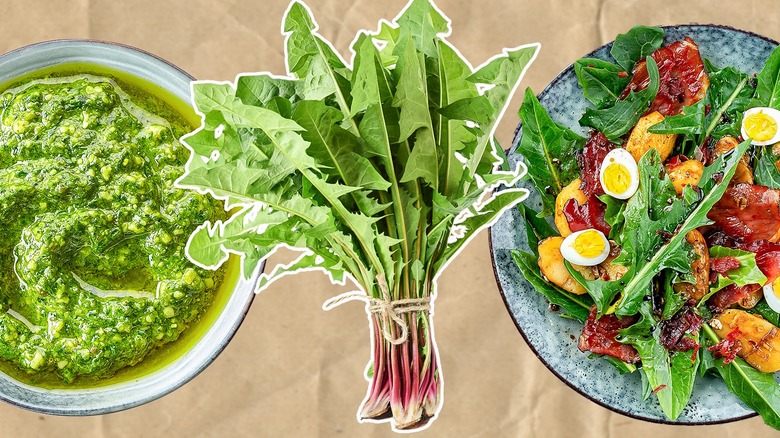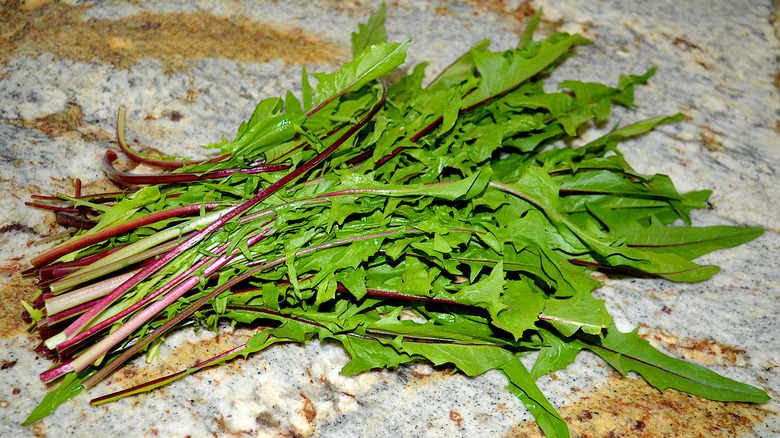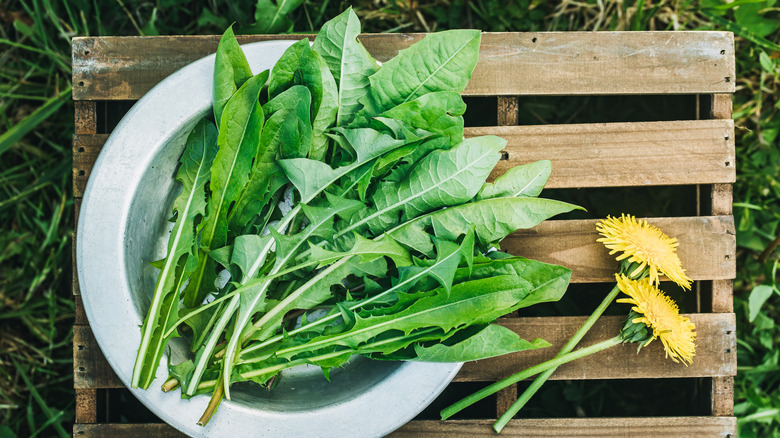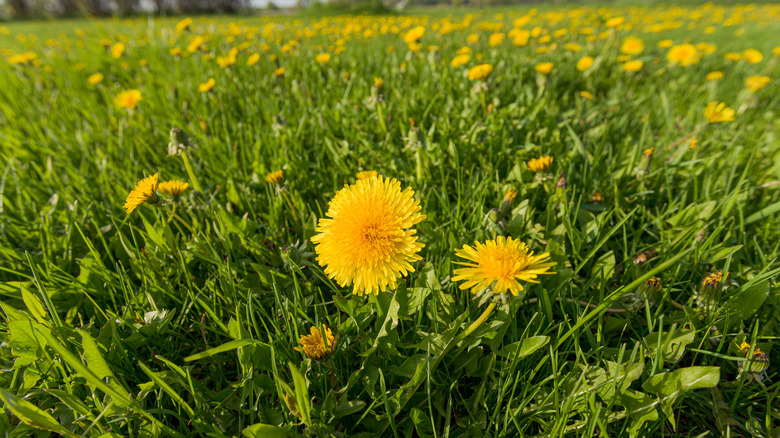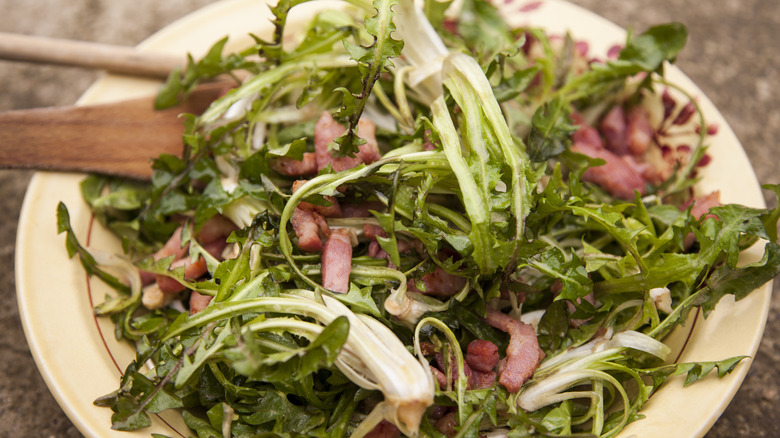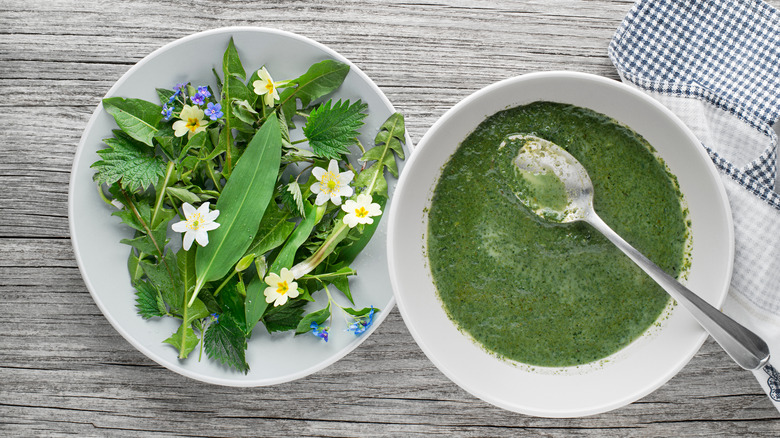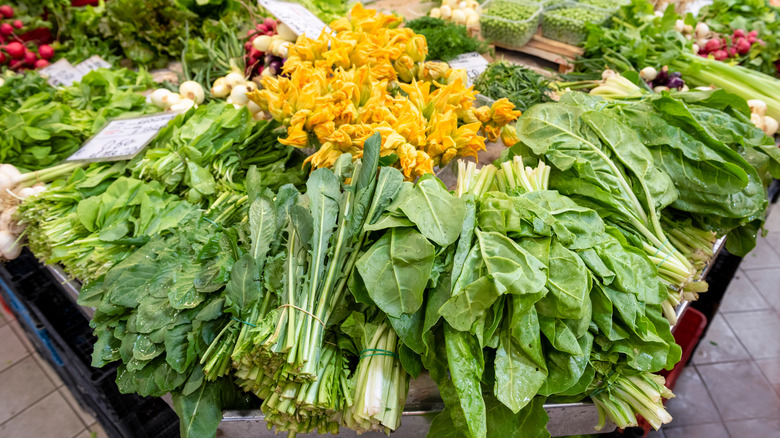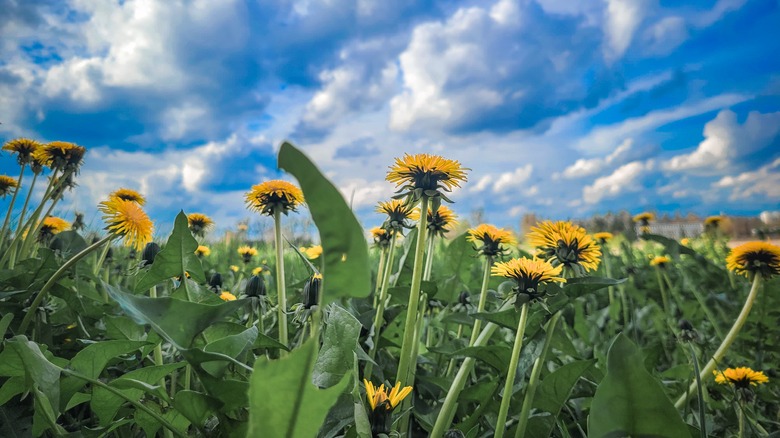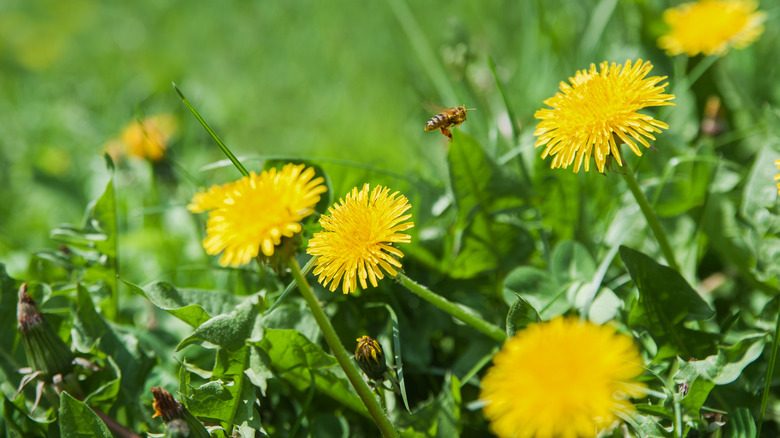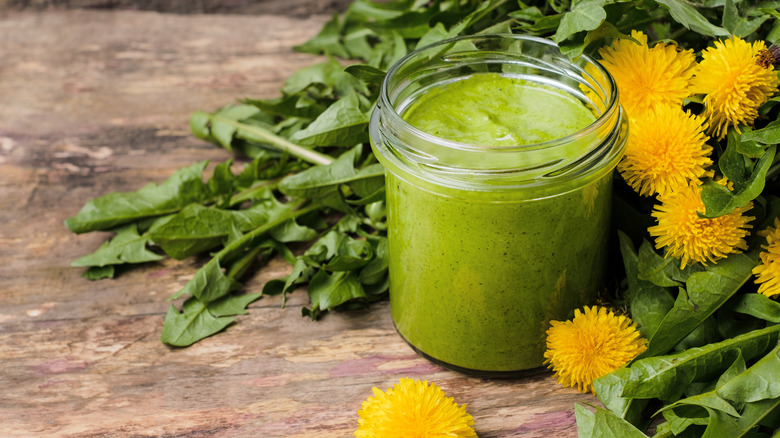What Are Dandelion Greens, And How Do You Incorporate Them Into Your Meals?
The dandelion is a very common plant in North America, with long, jagged leaves and distinctive yellow flowers that close before developing into fluffy white seed heads. Many people can identify a dandelion, including children who eagerly make wishes while blowing on the puffy seeds. What people don't always know is that dandelions are edible.
Dandelions are also hard to get rid of, since they can grow 15-foot roots and produce 5,000 seeds a year. Homeowners go to great lengths to try eradicating these plants, considering them as pesky weeds that can quickly overwhelm lawns and gardens. It may be wise to rethink this reputation, because dandelions have been used over thousands of years for sustenance and healing benefits. All parts of the plant are edible, they are highly nutritious, and they can be foraged locally.
We reached out to two experts to learn more about these incredible plants. Alan Bergo is a chef, forager, James Beard Award recipient, and the author of "The Forager Chef's Book of Flora." Frank Giglio is a chef, educator, and wild food enthusiast who currently works for Ararat Farms in Lincolnville, Maine. The knowledge they share may just inspire you to try foraging wild dandelions yourself, or purchasing cultivated ones to try in satisfying and nutritious recipes.
What are dandelion greens?
The common dandelion (Taraxacum officinale) originated in Eurasia but is widely found in temperate regions of North America. While it can be regarded as a vegetable in the kitchen, dandelions are classified as a weedy perennial herb. They are part of the Asteraceae family, which also includes plants such as artichokes, lettuce, endives, and sunflowers.
Dandelion greens are the leaves of the dandelion plant and are sharply toothed. This is likely why the name came about; it is derived from the Latin "dens leonis," which was translated to "dent de lion" in French (meaning "lion's teeth"), and this is the origin of the plant's English name. The smooth green leaves can be consumed raw or cooked and are generally harvested young, when they have the least bitter taste.
Every part of the dandelion plant may be consumed, including the yellow flowers, which can have a sweet taste and be tossed into salads or made into dandelion wine. Additionally, the roots — after drying and roasting — are used to make a coffee-like drink. The plant's bitter qualities come from a milky sap that discourages bugs and animals from eating it.
What do dandelion greens taste like?
Although most people can identify dandelions, not everyone is familiar with their taste, and many may avoid them because all they know is that they're bitter. Alan Bergo confirms that this bitterness leads to skepticism about the taste of dandelions but insists that this shouldn't be a determining factor. "They're an ancient food that's been harvested around the world for a very long time," he says. "Besides bitterness, dandelions also have a celery-like taste."
If you don't eat a lot of vegetables, or stick to ultra-palatable processed foods, dandelions will probably taste unacceptably bitter, at least at first. Vegetable lovers may enjoy them right away or, as was the case for Bergo, gradually come to like them more over time. "I crave the taste of dandelions, and so do many of my friends, but it's an acquired taste, kind of like learning to like hot sauce," he says.
If you want to tone down the flavor, you have options. "Cooking dandelion greens will help mellow out the bitterness," Frank Giglio says. This is why they're often blanched before being used in recipes. The time of year when you harvest them also matters. Bergo says that dandelion greens are always bitter, but very young plants will have a milder taste, so he recommends harvesting them before the yellow flowers appear.
Do wild and cultivated dandelions taste different?
All cultivated plants have their origins in the wild, from the time before humans started farming, and dandelions are no exception. Several factors of cultivation influence their taste.
"The intensity of the bitterness can vary drastically between cultivated and wild plants, the type of soil they're in, and how much shade they get," Alan Bergo says. "Wild dandelions will always taste stronger than cultivated dandelions." Bergo explains that strains of farmed dandelions have likely been selected because they have a milder taste, and that the resulting produce is grown in ideal conditions and is always harvested before flowering.
While it's been theorized that ancient humans started breeding bitterness out of crops with the advent of agriculture, bitterness has increasingly gone out of style in modern times, with foods like Brussels sprouts and Belgian endive being bred to have a milder taste in order to increase sales. However, eschewing bitter vegetables may not be the best move for our health, as these foods have been shown to contain more phytonutrients, which may prevent disease. Frank Giglio agrees, saying that "people try to avoid bitter flavors in food, but in doing so, forgo the medicinal properties that come with such ingredients."
How to prepare raw dandelion greens
Eating raw dandelion greens is generally safe, so you can enjoy these leaves in your favorite uncooked recipes. Purchase the freshest dandelion greens you can find, or forage them when they're young. Rinse them thoroughly to remove clinging soil, and chop off any thick stems.
Dandelion leaves have a place among the top types of greens that are perfect for salads. If you find the flavor too strong, Alan Bergo recommends mixing them with other greens that you like, which will provide a pop of contrast. "Young dandelion greens can be good mixed into a salad of different mild-tasting greens, where they'll add texture and flavor," he says. "In France, young dandelion greens are often tossed with lardons and a dash of red-wine vinegar and hard-boiled egg for a rich salad." Bergo's own dandelion salad recipe includes balsamic vinegar, garlic, maple syrup, and chives to hit a range of flavor notes. He also recommends mixing dandelion greens with milder vegetables like cabbage in slaws.
Frank Giglio finds that citrus fruits pair well with young, tender dandelion greens, and he adds segmented oranges or lemon juice to dandelion salads. Giglio also offers creative suggestions for using the greens raw. "One of my go-to preparations for dandelion greens is pesto. I swap out the basil and replace it with tender dandelion greens," he says. "Young greens can be added to green smoothies, or get run through a juicer with a combo of celery, cucumber, and apple."
How to cook with dandelion greens
Dandelion leaves are definitely one of the leafy greens you should be cooking with. "Dandelion greens can be eaten raw, but most people will enjoy them more if they're cooked until tender, especially if they're new to them," Alan Bergo explains.
Bergo recommends pairing dandelion greens with richly flavored ingredients that help cut the plant's bitter edge, including foodstuffs like garlic, onions, fish sauce, and salty cheeses like pecorino. He adds that dandelion leaves are delicious with bacon, ham, or smoked pork, which makes these greens a perfect addition to a ham and white bean soup. Bergo also suggests using dandelion leaves in hindbeh, a Lebanese vegetable dish featuring sautéed onions. "The sweetness of the caramelized onions pairs perfectly with the bitter greens," he says.
Frank Giglio also recommends ingredients that offset or complement the greens' bitterness, like olive oil, red pepper flakes, and citrus fruits like lemon, orange, and grapefruit. For a richer touch, he says that "bacon, dates, and blue cheese all complement each other, and get along great with dandelion." Giglio loves adding these unique greens to pasta dishes, especially "rigatoni or penne tossed with wilted dandelion and a sauce made from reduced chicken stock, garlic, lemon, and freshly grated Parmesan." Miso soup finished with chopped dandelion greens is a regular favorite for Giglio, and he sometimes enjoys breakfasts of sautéed dandelion mixed into scrambled eggs.
Fermenting dandelion greens
For anyone wondering if dandelion greens can be fermented, the answer is yes. "Fermenting dandelions is a great way to use them, as it adds layers of flavors beyond the bitterness most people expect," Alan Bergo says. He uses the greens to make kimchi, a spicy and fermented Korean side dish. Different types of kimchi can be made from a variety of vegetables, including cabbage, radishes, cucumbers, and wild mustard leaves — and dandelion greens work just as well.
In fact, kimchi is an ideal way to use dandelion leaves, according to Bergo. "The strong flavors of fish sauce, chili flakes, garlic, and ginger perfectly complement and balance the bitter greens, turning them into a spicy, salty, sour, and bitter condiment that's bursting with flavor," he says. Using dandelion in kimchi is also a good way to incorporate bitter greens into your diet, as it's mixed with other tasty ingredients, so that the bitter flavor of dandelions is mellowed by the accompanying flavors.
Dandelion leaves aren't the only part of the plant that can be fermented. Frank Giglio enjoys turning the yellow flowers into dandelion wine during springtime. This earthy, sweet, and slightly bitter beverage has a long history. Making dandelion wine "is an easy process, but takes about a year of waiting while the brew slowly ferments and ages. For many years, it was a tradition to make these beverages, then share it with friends the following year when you made a new batch," Giglio says.
Where to buy dandelion greens
Dandelion greens can be purchased at grocery stores, but they're not as common as other leafy vegetables like spinach, mustard greens, and turnip greens. You're more likely to find dandelion leaves in stores that offer a wider range of produce. When in stock, dandelion greens can be found in the fresh produce section. If your go-to supermarket doesn't sell them, you may have a better chance of finding them at farmers markets or supermarkets that specialize in natural or organic foods.
Make sure to buy the freshest leaves you can find. "Seek out firm bunches without any signs of wilting. Any yellowing should be avoided as well when purchasing these greens," Frank Giglio advises. Avoid bunches with large, tough stems, or make sure to remove them before preparing the leaves. Springtime is the best season to source young dandelions that haven't yet produced flowers and are thus less bitter, though older dandelion greens are acceptable if you're planning to cook them.
Keep in mind that the dandelion greens sold in grocery stores aren't the same as what you'll find when foraging. Giglio says that store-bought dandelion greens have almost always been intentionally bred to be less bitter than wild plants. And if you develop a craving for dandelion greens but can't find them in stores, Giglio suggests kale or collard greens as ingredient swaps for cooked recipes, while "radicchio would be my preferred substitute in salads, and arugula would make a great pesto."
Where to forage dandelion greens
Wild dandelions are not hard to find, and there are many good reasons to pick them yourself. For Frank Giglio, a big advantage of foraging is that this activity "gets you outside, in nature, and connects you more deeply to the plants in their natural habitat."
Where you begin a dandelion hunt may depend on your own approach to lawn care. "Backyards are a great place to start, but only if your lawn is free from chemicals," says Giglio. For safety reasons, Alan Bergo advises against picking dandelions that may have been exposed to toxic substances, like pesticides or car exhaust. "I avoid places near contaminated water or soil, as well as busy roadsides and anyplace that I suspect has been sprayed with pesticides," he says. "Washing them won't necessarily make them safer. It's also just easier to harvest dandelions from a clean place you know and trust."
If you don't have a backyard and aren't sure if public locations are free from toxins, Bergo and Giglio both approve of a great solution — offer to do some weeding for a local organic farmer in exchange for keeping the fresh dandelions that you pick. No matter which approach you take toward collecting this ingredient in the wild, according to Bergo, "the biggest benefit of foraging your own dandelion greens is that they're free."
How to identify dandelion plants and avoid look-alikes
Finding edible plants you can forage is almost always very satisfying, but before you try to harvest them yourself, take some time to learn about their characteristics in detail. There are some look-alike plants — like sow thistle or coltsfoot — that can easily be confused for dandelions. True dandelion leaves are deeply jagged and have no fuzz, and the stems, which are hollow, each produce only a single flower. Spotting fuzzy leaves or multiple flowers on one stem indicate that you've found a look-alike.
Alan Bergo considers dandelions to be a good plant for anyone who is just getting started in seeking out wild food, because these greens are already widely known and identifiable. "Dandelions have no dangerous look-alikes, and are one of the easiest plants for beginning foragers," he says.
Nonetheless, Frank Giglio urges amateur foragers to be careful. "There are other wild plants with yellow flowers, but the leaf structure differs," he says. "First and foremost, don't harvest any plant you can't identify, and especially don't eat any ingredients you are not familiar with. Find a few books that focus on your region and educate yourself." Giglio also recommends seeking out experienced foragers who host excursions to gather wild foods, providing firsthand experience with identifying plants. "Many beginners try to learn dozens of plants all at once and can get overwhelmed. Pick a few plants that grow in your area and work your way up," he says.
Nutritional information about dandelion greens
Dandelions have long been known to provide health-promoting effects, with their applications addressing a long list of conditions ranging from fever to dandruff. Like many leafy greens, dandelion leaves are very nutritious. They provide high amounts of fiber and vitamins A, C, and K, along with important minerals like calcium, iron, and magnesium.
It's not just dandelion greens that offer benefits. All parts of the plant — including the flowers, crowns, and roots — are edible and can provide helpful nutrients. Dandelion roots contain a soluble fiber called inulin, which promotes a healthy gut microbiome. Tea is a popular way to consume the roots after they are dried. The flowers contain the highest concentration of polyphenols, which are antioxidants that neutralize free radicals and help prevent disease.
Dandelions have long been used to help detoxify the body. "Dandelion leaves are known to aid in digestion. Consuming dandelion leaves increases urine production, which helps eliminate toxins from the body," says Frank Giglio, who chops up and dries dandelion roots to make tinctures or apple cider vinegar infusions. The plant can also be good for your skin. Dandelion extract has shown promising effects against sun damage, wrinkling, and acne.
How to store dandelion greens
Whether you're preparing a simple dandelion greens recipe or some unique dandelion pesto, your dish will taste better with the freshest greens. They're best kept chilled to stay fresher for longer, unless you're planning to use them immediately, according to Alan Bergo. "After harvesting dandelion greens, they should be soaked in cold water to clean and refresh them, then spun dry and put into a zip-top bag or a container you like to store leafy greens in, and refrigerated," he says, while warning that dandelions stored in a paper bag will dry out in the fridge after a few days.
The texture of vegetables is generally best when consumed fresh, but dandelions aren't generally in season during wintertime. Whether you want to have dandelion leaves available in the winter months, or you have a large quantity of them that you don't want to go to waste, freezing the greens is a good solution to make them last longer. Fresh and frozen vegetables have a very similar nutritional content, so you don't have to worry about them being less healthy.
"To freeze dandelion greens, they should be blanched in lightly salted water until just wilted (30-60 seconds), wrung dry, put into a zip-top freezer bag, labeled, dated, and frozen, where they'll last for six months," Bergo says. If you're not sure how to use the frozen greens, Bergo offers a tip: "I like to add frozen dandelion greens to soups and stews."
